|
Heavy varmint rifles, and by that I mean rifles
weighing over ten pounds ready to go, are a very specialized
type of weapon. They are built for precision long range shooting.
They are much akin to the heavy-barreled sniper type weapons
used by the military and by specialized law enforcement units.
The main difference is the targets. Both types of rifles demand
precision, sometimes at extended ranges. Both usually wear heavy
barrels, have decent triggers, and wear quality scopes built for
shooting at long range. Savage builds several rifles that fit
into one or the other categories, that they market to law
enforcement and varmint hunters. However, they only have one
that they call the "Varminter", and it is featured in
this article. The Savage 12VSS Varminter is, in my opinion, the
ultimate heavy varmint rifle. The one featured here is chambered
for the .22-250 cartridge, which is the quintessential varmint
cartridge. The rifle is also available chambered for the .223
Remington and .308 Winchester cartridges.
The Varminter features all the goodies. It wears
a Choate synthetic stock that is built for long range shooting.
The stock has an accessory rail under the forearm for mounting
of a bipod. It has an adjustable spacer kit to vary the length
of pull. It comes with two cheek pieces to properly align the
shooterís eye with the scope. The Choate stock wears sling
swivel studs on either side of the forearm and buttstock, and
has an adjustable monopod under the buttstock that, when used
with a bipod, gives a three-point rest that is very stable
shooting from prone or from a bench. It is an exceedingly
comfortable stock to use for extended shooting sessions.
The Varminter wears a heavy profile fluted
stainless steel button-rifled barrel that is free-floated into
the Choate stock. The stainless action has the safety mortised
into the tang, just as it should be. The Varminter wears a large
bolt handle knob for easy operation, and the internal magazine
holds four cartridges. The rifle weighs eleven pounds and four
ounces, and of course, it has that wonderful AccuTrigger that
allows a shooter to adjust the pull weight down to a crisp one
and one-half pounds, for precision work.
The ultimate varmint rifle also deserves the
ultimate varmint scope. For this, I chose the Leupold VX-III
Long Range scope with the Varmint Hunterís Ballistic Aiming
reticle. This scope has a matte black finish and is built on a
30mm tube. It has a side mounted focus and finger-adjustable
windage and elevation turrets with one-quarter minute click
adjustments. The Varmint Hunterís reticle allows the hunter to
estimate the range to target, and then hold directly on the
aiming point which correlates with the distance to the target.
It also has markings to allow for wind deflection at various
ranges. The picture shows a view through the scope, but
the illustration below shows more clearly the reticle, and the
chart shows the ballistics of two different classes of varmint
cartridges, which determines which setting on the scope that the
shooter uses for his particular rifle. I lifted this chart from
Leupoldís website, to better illustrate how the reticle works.
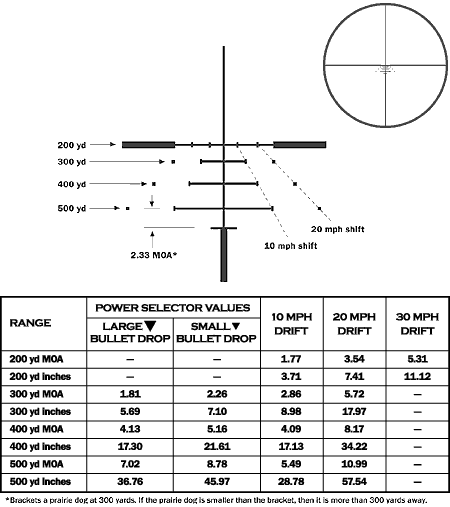
This Leupold scope is just perfect for the
ultimate varmint rifle. While the 12VSS is Savageís best heavy
varmint rifle, in my opinion, every one of their varmint guns
that I have tried has been accurate and trouble free. The stock
on the 12VSS makes it easier to shoot accurately than their
other varmint guns, but all use the same high quality actions
and barrels, and all have the AccuTrigger. Choosing any of their
varmint rifles would not be a mistake, and I recommend them
often. However, there is something really special about this
particular 12VSS Varminter that makes it, for me at least, the
ultimate varmint rifle. You see folks, I built this rifle with
my own two hands. I didnít order a stock and bolt the
action into it. I went right up to the factory and built it
myself, with the help of the skilled craftsmen at Savage Arms.
Back on April 7th of this year, I received an
email from the Marketing Services Manager at Savage Arms,
inviting me to come up to Massachusetts to build my own rifle. I
was both pleasantly surprised and humbled at the same time. I
didnít know why they invited me, but I decided that I better
get up there before they changed their minds, so it was not long
before I headed the Harley towards the Mason-Dixon line. Hearing
of the horror stories of entering that anti-gun region, I
decided not to pack a weapon with me. After a bit more thought
on the subject, I decided to pack a weapon that I could, if
necessary, throw away. Since the statute of limitations has not
yet expired, I will not go into any further detail on that
subject.
It was a very pleasant ride up through the
mountains, and I found that part of the country to be very
scenic and relaxing. I was making good time, so a side trip to
Gettysburg battlefield was in order. Visit there if you ever get
a chance. Crossing Connecticut was an interesting experience.
Those folks drive their cars like they just stole them! The
speed limit was 55, so I finally got over into the right lane
and slowed the Road Glide down to about 80 and let everybody go
on by.
Arriving the afternoon before I was scheduled to
build the rifle, I was treated to supper at a very nice place by
two members of Savageís management, Brian Herrick and Paula Iwanski,
enjoying a good meal, fine company, and an interesting
discussion of upcoming products to be introduced into the Savage
line, laced a bit with some interesting history of Savage Arms,
and the New England gun industry in general. I naturally begged
for the reintroduction of the grand old Model 99, but it most
likely will not happen. Too soon the evening was over, and I was
returned to my hotel to make an attempt at getting some sleep.
I was picked up at 6:30 the next morning and
driven to the factory, which was a sight to behold in itself. It
was the same old brick building that I had seen pictures of
since my youth. Stopping at the guard shack, I was given a
name badge that they had prepared for me, and proceeded to the
lobby.
I could have spent all day in the lobby,
especially if I could have opened those glass showcases and
fondled the guns within. There were many rare Savage rifles in
there. I would sell a kidney to obtain a trim little scaled-down
model 99 prototype that was chambered for the .32-20 cartridge.
On second thought, I would sell both kidneys and go on dialysis
for that little rifle! There were so many old rifles in there,
that it was like history was alive just beyond the glass.
After lusting over the rifles and steaming up
the showcases, it was time to go to work. Entering the factory
floor, I was immediately impressed by the vast amount of
machinery that it takes to build a rifle. There among the latest
high-tech computer controlled machines were many old Pratt &
Whitney lathes and boring machines. There were milling machines,
rifling machines, and one old machine that does nothing but
straighten any slight bend in a barrel, making it perfectly
straight. They all looked straight to me, but the man peering
down each and every Savage barrel made certain that they were
perfect. I was impressed with the broaching machine that pulls a
long broach through the receiver to cut the square raceway for
the bolt lugs. I had never seen that done before.
I was allowed to do any operation that I liked,
and I tried them all. I was surprised at how much hand work goes
into a rifle. Of course, I was closely supervised by the machine
operators at each station to assure that I screwed nothing up.
Since the gun that I was building was stainless, I did not get
involved in any bluing, but I did get to observe the polishing
tank into which the barreled actions were placed to achieve that
highly polished finish. It was much like a huge cartridge case
tumbler, loaded with ceramic stones. This process allows Savage
to produce a beautiful polished blued finish at a low price. A
good example is the Savage Model 40 .22 Hornet that I recently
reviewed. It is finished better than some rifles costing more
than three times its price.
One person was assigned to take me through the
factory, as I worked at different stations building the rifle.
While at each
station, I got to meet and learn from the folks who do that
particular operation every day, and it was with these people
that I was most impressed.
Some of the craftsmen (and craftswomen, if that
is a word) have been at Savage Arms for many years, and some of
those years were pretty lean times for the company. Others that
I met had been working there for only a couple of years.
However, everyone with whom I spoke, and I got to talk with a
bunch of them, were truly proud of the products that they were
building. It was the kind of good old Yankee Union pride that is
sadly missing from many companies these days. I had really
expected to meet a bunch of rude people in Massachusetts. I was
wrong. These were some of the nicest folks that I have
ever met, and each one of these union workers had nothing but
great respect for the management that brought Savage Arms back
from the brink of extinction a few years ago. After building the
rifle, I proof fired it, and it was sent to get a serial number
assigned while they fed me a fine lunch that I got to enjoy
while visiting with some more of the executives at the outside
screened gazebo. We mostly discussed the cost of living in New
England. I honestly do not see how these folks make a living up
there. They are taxed beyond belief on their homes, and the
prices of homes up there is unbelievable to me. The fact that
they can produce fine, accurate weapons and sell them at a price
consistently below their competition is a testament to the
efficiency of their workers and the design of their rifles.
After lunch, Paula and I went upstairs to the
range to to test fire the rifle, then we went back downstairs to
meet Effie Sullivan, who knows more about Savage rifles and how
to build them than you and I will ever learn. She knows her
guns, and is the head troubleshooter should you ever experience
a problem with any of their products. The Varminter was
then packaged up and shipped back home for me, where it was
waiting at my dealerís shop when I got there.
The Savage 12VSS is a fine rifle, as accurate as
any that I own, and a lot more accurate than most. With the
right ammo, it will shoot one-hole groups at 100 yards. I highly
recommend it. I wonít get into different loads and pictures of
group sizes in this article as I normally do, for that is not
really what this story is about. It is not as much about the
rifle as it is about Savage Arms, and Savage Arms is about
people. I went to New England to build a rifle, but I came back
with much more than that. I gained a greater respect for the
people that build our guns. Before the guns show up on the
dealersí gun racks, there are many good people involved in
many different operations to turn that bar stock and forgings
into an accurate, reliable weapon. They are people who
take pride in their work, and in the product that leaves the
factory. At least it is that way at Savage. I hope that it is
this way at other gun companies also. Long after the
newness wears off of this rifle, I will remember with fondness my first trip
to New England, and the genuine hospitality that I enjoyed at
Savage Arms.
Check out the extensive line of Savage and
Stevens products online at: www.savagearms.com.
For a closer look at some of the finest optics
available, check out: www.leupold.com.
For the location of a Savage dealer near you,
click on the DEALER LOCATOR icon at: www.lipseys.com.
Jeff Quinn
|
To locate a dealer where you can
buy this gun, Click on the DEALER FINDER icon at: |
|

|
  
Got something to say about this article? Want to agree (or
disagree) with it? Click the following link to go to the GUNBlast Feedback Page.
|
|
Click pictures for a larger version.
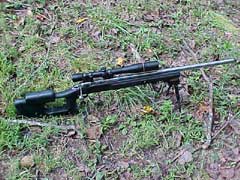
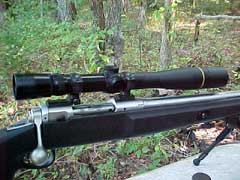
Savage's 12VSS Varminter.
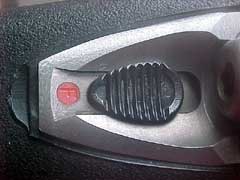
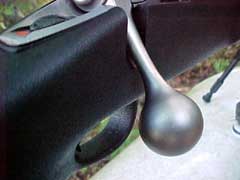
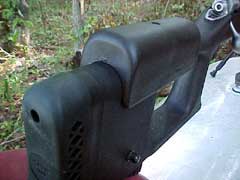
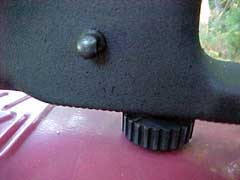
Savage is known for making some of the most accurate
factory rifles available anywhere at any price, and Jeff's
12VSS is no exception.
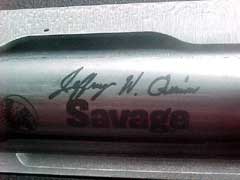
As a "custom touch", Savage laser-etched
Jeff's signature on the gun's bolt, right above the Savage
logo.
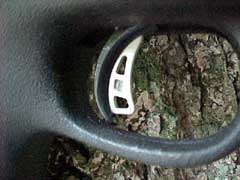
Savage's AccuTrigger:
the finest trigger ever offered on a factory rifle, the
AccuTrigger is superior to, and safer than, many custom
triggers costing hundreds of dollars.
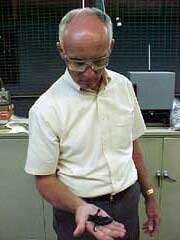
The man who invented the AccuTrigger.
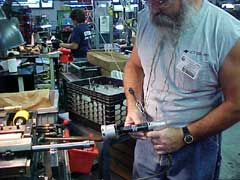
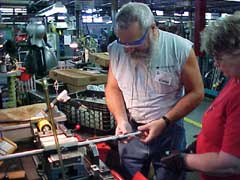
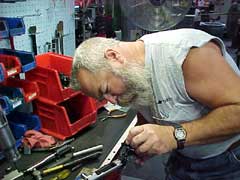
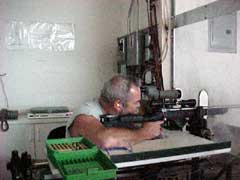
Author builds and test-fires his 12VSS.


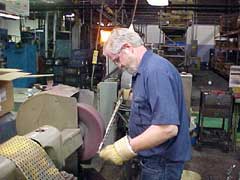

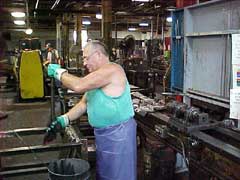

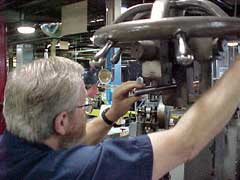
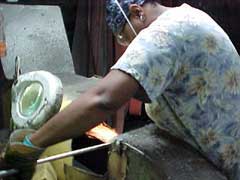

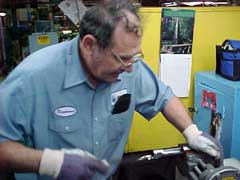
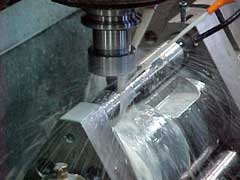
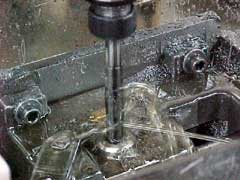
Any company is no better than the people who work there,
so it was no surprise to Jeff to find that the folks at Savage
are fine examples of the American worker. They take pride in
their work and are experts in their assigned tasks, combining
Old-World craftsmanship with modern manufacturing techniques
and cutting-edge technology.
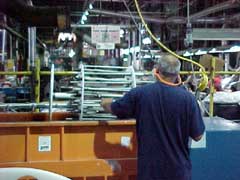
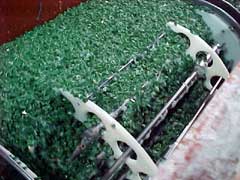
Barrels are polished in ceramic media before bluing.
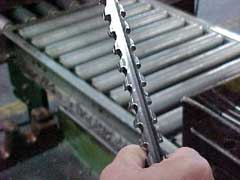
Broach for cutting bolt lug channels in receiver.
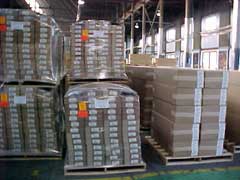
Rifles awaiting shipment.
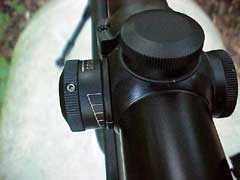
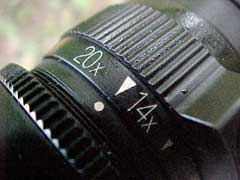
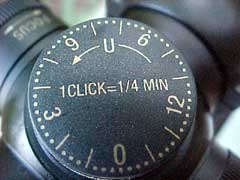
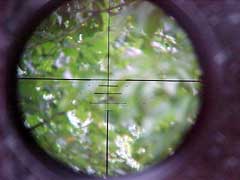
A fine rifle deserves an equally fine scope, so Jeff
chose Leupold's VX-III
Long Range scope with Varmint Hunterís Ballistic Aiming
reticle for his 12VSS.
|
![]()